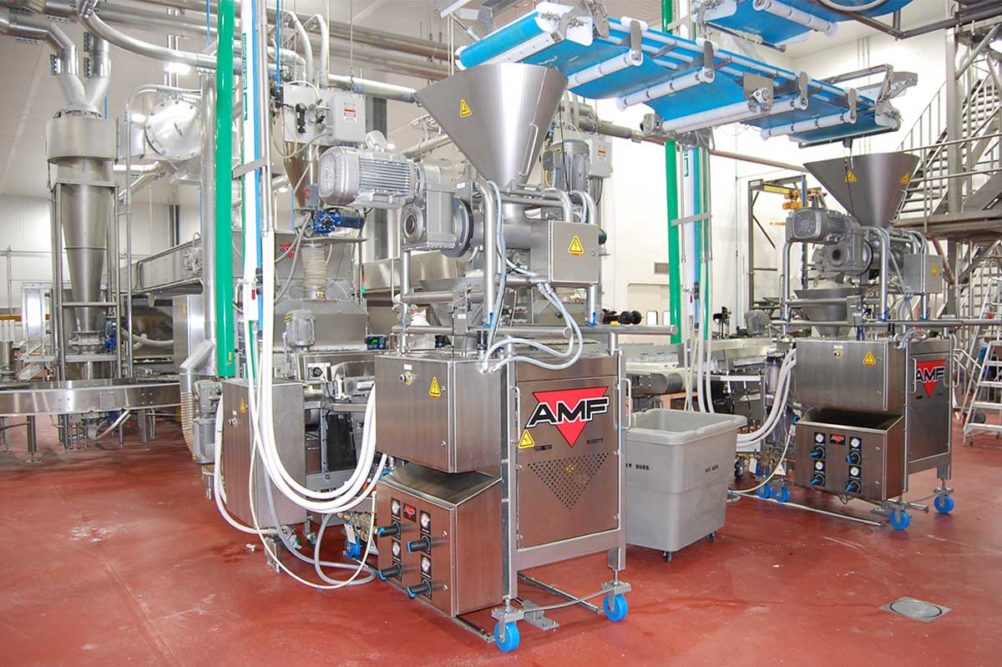Significant mechanical stress occurs in a dough divider, especially when it’s running around-the-clock. That’s because the components in a divider are precise and must wrestle with the resistance of dough as it’s processed. Today’s advances in cutting and extruding have limited the risk of divider failure, especially if it is properly operated, cleaned and maintained.
“Parts do wear over time, and periodic inspections to determine the extent of any wear should be conducted as part of a preventive maintenance program,” said Ken Johnson, president, Gemini Bakery Equipment/KB Systems.
Of course, there are several types of dividers, and each faces different maintenance issues. Developing a specific preventive maintenance program is critical to keeping lines running. No matter the type, dividers generally lose accuracy when the tolerances of the portioning pumping elements wear down, explained John McIsaac, vice president of strategic business development, Reiser.
“In some dividers this means a major rebuild on a regular basis,” Mr. McIsaac said. “In some dividers, it is simply a swap of one or two components to restore factory scaling.”
Because bakers remain on the front line of a pandemic that in many instances requires continued record levels of output, any downtime means opportunity lost. So while dividers must run, run, run, taking time to schedule important maintenance and repairs can keep operations running smoothly.
“We see that the awareness of taking care of the equipment has increased over the last years, and many of our customers are now looking into more preventive service on their equipment,” said Magnus Soeson, area sales manager for the United States, Canada and Latin America, with Glimek, a Middleby Bakery company. “This gives a longer life span for their equipment and prevents unforeseen production stops.”
Foreign objects and debris are the main cause of dough divider failure, according to Bruce Campbell, vice president of dough technologies, AMF Bakery Systems. Following closely behind are parts worn beyond their service limits with improper or no maintenance.
“The No. 1 thing that bakeries can do to avoid issues and keep their dividers running smoothly is install metal detectors before their dividers,” Mr. Campbell said. “Dough dividers are built to divide dough and nothing else, so by taking steps to ensure that nothing but dough enters the divider, you can avoid divider failure.”
In addition to keeping foreign objects out, strategic maintenance and repair of dividers has changed in the past five years because of constant evolutions in designs and components. AMF is designing new systems that require the least amount of maintenance and human intervention.
The vacuum system remains one of the primary pain points associated with many dough dividers. These problems arise when there are bad relays of PLC output cards and with failed solenoid valves and debris in the vacuum lines. AMF designed Vector technology that has all but removed these issues.
“The two main reasons that this technology has been able to eliminate the vacuum issues are that the vacuum is induced into the machine from a different location and the auger design prevents dough from entering the vacuum system,” Mr. Campbell explained.
Each part is susceptible to its own form of wear, causing the divider to run out of spec and resulting in poor scaling, increased downtime, extra labor and more.
[Related Reading: Preventative maintenance on dividers key to long life]
“Some specific conditions to each bakery or production line may accelerate that wearing process such as stiff or high-gluten dough formulations, inclusions present on the dough, very cold temperature, higher production speeds, long production shift operations, lack of maintenance and poor sanitation,” said Cesar Zelaya, bakery technology manager, Handtmann.
The effects of wear over time due to mechanical stress can be foreseen and corrected with effective preventive maintenance inspections and replacement of critical parts. Lack of lubrication as well when working with difficult-to-portion doughs can accelerate wear on sliding machine surfaces.
“Lack of lubrication between the tolerances of the moving parts on suction-type dividers will create underweight dough pieces due to air being drawn into the suction chamber,” explained Keith Collins, senior field engineer, Gemini. “This air can also cause undesirable holes or gas pockets in the final baked product as well.”
He advised operators make sure bearings, bushings and cam followers are all well-lubricated and special attention be paid to oil pumps, metering valves and dosing valves.
In addition to proper lubrication, Gemini and Werner & Pfleiderer developed special alloys that lengthen the life cycle of dividers dramatically. It’s sour resistant (SR) dividers were designed to improve machinability of stiff and high-gluten doughs.
“The material in an SR unit has a stainless-steel surface appearance, is smooth and sealed to prevent acids from penetrating the castings,” Mr. Collins said. “These materials are corrosion resistant and provide for water-friendly cleaning.”
For volumetric dividers, Jay Fernandez, master baker at the Middleby Bakery Innovation Center, recommended using the manufacturer’s specified divider oil.
“If considering an extrusion system, our Wave dividers have large slow-rotating polymer screws that won’t wear its housing,” Mr. Fernandez said. “This along with individual sine pumps that have a suction side to reduce pressure at the manifold will reduce load on the main double screw components.”
The Wave SSP 600/800 Servo Bun Divider from Stewart Systems, a Middleby Bakery company, features large diameter polymer double screws that rotate slowly and prevent dough sticking.
Rheon’s stress-free dividers create a dough sheet by chunking dough logs onto a conveyor to create a continuous dough sheet. This dough sheet then runs over a conveyor that has load cells beneath it and cuts each piece at the specified weight. Typical failures on these lines are related to a sensor being obstructed or a load cell that needs to be zeroed out, said John Giacoio, vice president of sales, Rheon USA.
“Both of these potential problems can be averted with regular cleaning of the divider,” Mr. Giacoio said.
This article is an excerpt from the December 2020 issue of Baking & Snack. To read the entire feature on dividing, click here.






